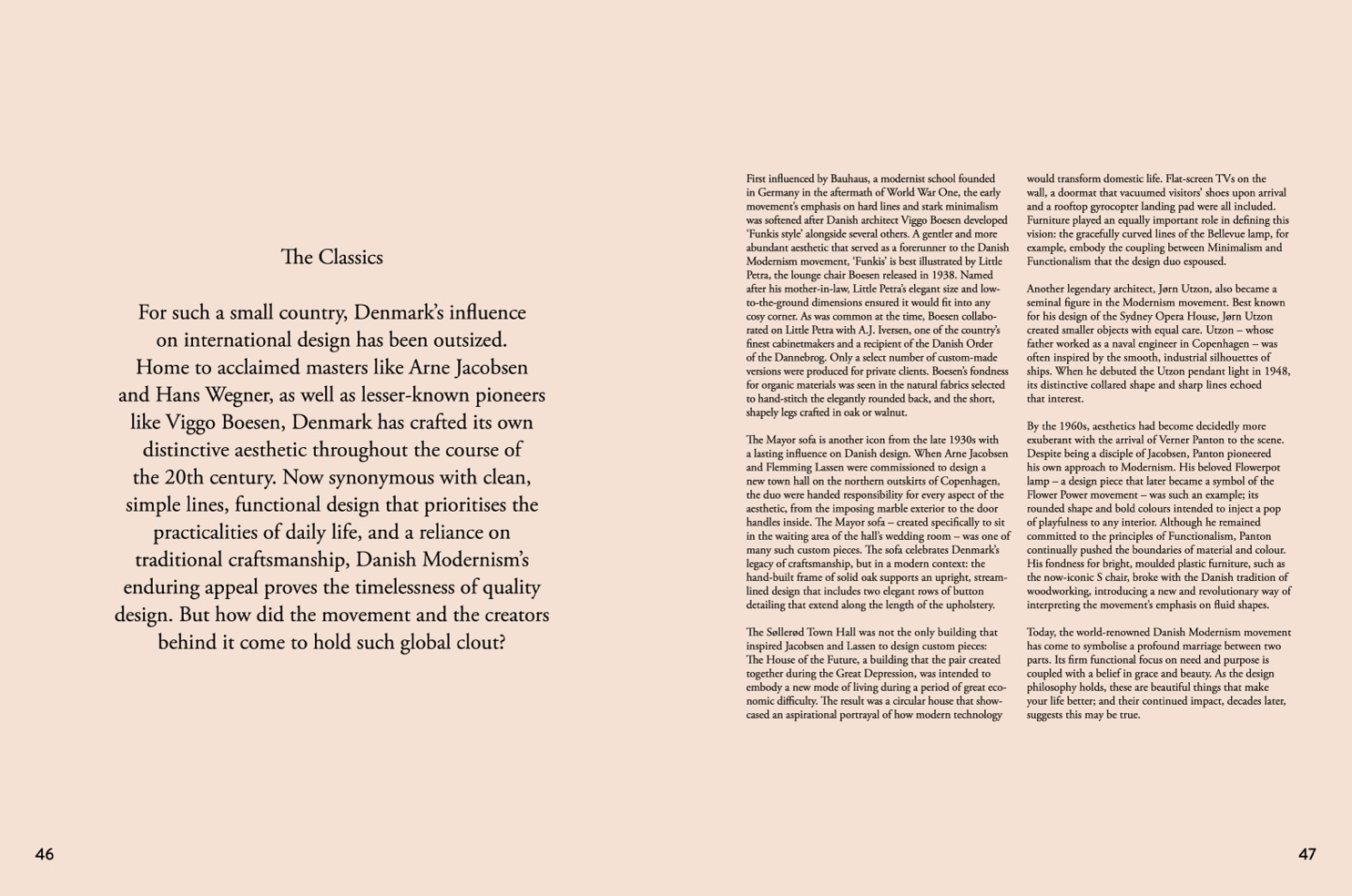
46
47
The Classics
For such a small country, Denmark’s influence
on international design has been outsized.
Home to acclaimed masters like Arne Jacobsen
and Hans Wegner, as well as lesser-known pioneers
like Viggo Boesen, Denmark has crafted its own
distinctive aesthetic throughout the course of
the 20th century. Now synonymous with clean,
simple lines, functional design that prioritises the
practicalities of daily life, and a reliance on
traditional craftsmanship, Danish Modernism’s
enduring appeal proves the timelessness of quality
design. But how did the movement and the creators
behind it come to hold such global clout?
First influenced by Bauhaus, a modernist school founded
in Germany in the aftermath of World War One, the early
movement’s emphasis on hard lines and stark minimalism
was softened after Danish architect Viggo Boesen developed
‘Funkis style’ alongside several others. A gentler and more
abundant aesthetic that served as a forerunner to the Danish
Modernism movement, ‘Funkis’ is best illustrated by Little
Petra, the lounge chair Boesen released in 1938. Named
after his mother-in-law, Little Petra’s elegant size and low-
to-the-ground dimensions ensured it would fit into any
cosy corner. As was common at the time, Boesen collabo-
rated on Little Petra with A.J. Iversen, one of the country’s
finest cabinetmakers and a recipient of the Danish Order
of the Dannebrog. Only a select number of custom-made
versions were produced for private clients. Boesen’s fondness
for organic materials was seen in the natural fabrics selected
to hand-stitch the elegantly rounded back, and the short,
shapely legs crafted in oak or walnut.
The Mayor sofa is another icon from the late 1930s with
a lasting influence on Danish design. When Arne Jacobsen
and Flemming Lassen were commissioned to design a
new town hall on the northern outskirts of Copenhagen,
the duo were handed responsibility for every aspect of the
aesthetic, from the imposing marble exterior to the door
handles inside. The Mayor sofa – created specifically to sit
in the waiting area of the hall’s wedding room – was one of
many such custom pieces. The sofa celebrates Denmark’s
legacy of craftsmanship, but in a modern context: the
hand-built frame of solid oak supports an upright, stream-
lined design that includes two elegant rows of button
detailing that extend along the length of the upholstery.
The Søllerød Town Hall was not the only building that
inspired Jacobsen and Lassen to design custom pieces:
The House of the Future, a building that the pair created
together during the Great Depression, was intended to
embody a new mode of living during a period of great eco-
nomic difficulty. The result was a circular house that show-
cased an aspirational portrayal of how modern technology
would transform domestic life. Flat-screen TVs on the
wall, a doormat that vacuumed visitors’ shoes upon arrival
and a rooftop gyrocopter landing pad were all included.
Furniture played an equally important role in defining this
vision: the gracefully curved lines of the Bellevue lamp, for
example, embody the coupling between Minimalism and
Functionalism that the design duo espoused.
Another legendary architect, Jørn Utzon, also became a
seminal figure in the Modernism movement. Best known
for his design of the Sydney Opera House, Jørn Utzon
created smaller objects with equal care. Utzon – whose
father worked as a naval engineer in Copenhagen – was
often inspired by the smooth, industrial silhouettes of
ships. When he debuted the Utzon pendant light in 1948,
its distinctive collared shape and sharp lines echoed
that interest.
By the 1960s, aesthetics had become decidedly more
exuberant with the arrival of Verner Panton to the scene.
Despite being a disciple of Jacobsen, Panton pioneered
his own approach to Modernism. His beloved Flowerpot
lamp – a design piece that later became a symbol of the
Flower Power movement – was such an example; its
rounded shape and bold colours intended to inject a pop
of playfulness to any interior. Although he remained
committed to the principles of Functionalism, Panton
continually pushed the boundaries of material and colour.
His fondness for bright, moulded plastic furniture, such as
the now-iconic S chair, broke with the Danish tradition of
woodworking, introducing a new and revolutionary way of
interpreting the movement’s emphasis on fluid shapes.
Today, the world-renowned Danish Modernism movement
has come to symbolise a profound marriage between two
parts. Its firm functional focus on need and purpose is
coupled with a belief in grace and beauty. As the design
philosophy holds, these are beautiful things that make
your life better; and their continued impact, decades later,
suggests this may be true.

